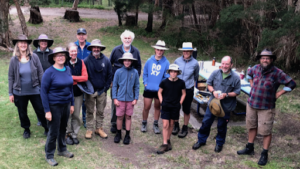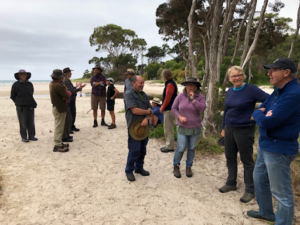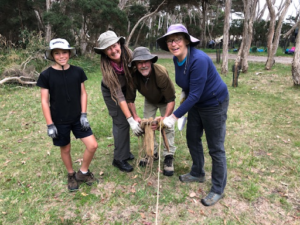Sisters Beach Wildcare
Sisters Beach Wildcare, North-West Tasmania
Our purpose is to help protect the coastline in and around Sisters Beach from erosion, and restore native vegetation. We use protective mattressing and other barriers derived from natural materials, to provide physical protection from sea surge and high rainfall runoff, of the existing soil, sand and plants. We supplement this protection with plantings of local native species.
Who we are.
We are residents and visiting friends of Sisters Beach, North-West Tasmania. We are working to help protect our foreshore, estuary and lower river from erosion, and to re-establish plants local to the area. Details of our work can be accessed via the Sisters Beach Community Association website at sistersbeach.org.au, by emailing our nominated contact person, or by leaving your details at Sisters Beach Store.
Where we work.
Our projects are based around Sisters Creek inlet, including the sand dunes on either side of the creek, and eastward, up to the beach of the Rocky Cape National Park. This includes the Paperbark woodlands around the estuary, the playground and car park.
In recent times the sand dunes are paperbark woodlands around Sisters Creek estuary have experienced erosion from king tides and storm surges, at levels that have not been experienced since the Sisters Creek hamlet was established. It is uncertain how frequently these erosion events will occur in the future, and whether they will increase in number and intensity. However, the long-term trends predicted by Coastal Risk Australia (www.coastalrisk.com.au), along with the recent experience of erosion along the North-West coast, and elsewhere in Tasmania and Australia more broadly, suggest that communities need to start taking action to address these anticipated impacts, and learn from these actions.
This project will be one of the first of its kind in Tasmania. By methodically documenting our outcomes, and consulting with other communities, we hope to become a case study of how local groups can address the effects of high impact coastal erosion. Via personal links, the project already has a network of some of the best advisers in Australia on the impacts of sea level rise, and how these impacts, and those of increasing storm surges, might be addressed by coastal communities.
What we do.
The project focuses on three major, inter-related sets of actions, working in cooperation with Sisters Beach Community Association and Waratah-Wynyard Council:
- Communicating with, and visiting, other coastal communities and sites of erosion and erosion control.
- Protecting coastal and estuarine areas from tidal flow and high-energy waves, and physically stabilising soil to protect from erosion.
- Revegetating with local plants to assist stabilisation and to protect and enhance biodiversity.
Site visits aim to find out what methods other communities are using to stabilise and revegetate coastal areas, and how effective previous stabilisation and revegetating efforts have been in resisting the recent high level erosion events, particularly on the North-West coast of Tasmania. We hope that these visits will also enable the set up of collaborations and networks with other communities facing similar challenges of extreme tide-induced erosion.
All rehabilitation activities are underpinned by embracing the ‘best practice’ ethos and approved by the appropriate land owner representative or agent. For example, protection and stabilisation will use a combination of natural materials (wood logs and brush), formed as anchored lattices, non-local materials (e.g. coconut fibre coirs, sand filled geosynthetic tubes), and repositioning of sand to protect sand and soil from erosion from high energy waves, and also help protect young plants from being broken and scoured out during revegetation.
Stabilising materials are anchored with a combination of wooden stakes and natural fibre ropes. Erosion control and revegetating areas are being fenced off, and signs put up to keep the local community informed about the specific project.
Revegetation focuses on the protection of pre-existing local native species, supplemented by the use of new plants, using mostly coastal species that are tolerant to salinity, grow quickly and develop deep root systems that can help to stabilise soil in the face of high tidal flows and sea surge. Other local native plant species will be added over time, to enhance biodiversity and aesthetics. Planting will be integrated with physical protection, so that soil scouring is minimised, and high energy waves broken up before they reach newly established plants, and that the newly growing plants are protected from physical damage.
Contacts
Secretary: Colin Hocking –


